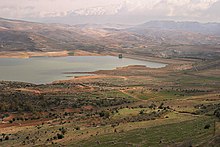
Many countries and territories have installed significant solar power capacity into their electrical grids to supplement or provide an alternative to conventional energy sources. Solar power plants use one of two technologies:
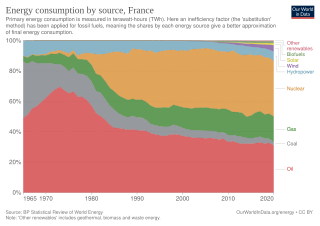
According to the International Energy Agency, France has historically generated a very low level of carbon dioxide emissions compared to other G7 economies due to its reliance on nuclear energy. Energy in France was generated from five primary sources: nuclear power, natural gas, liquid fuels, renewables and coal. In 2020, nuclear power made up the largest portion of electricity generation, at around 78%. Coal energy is declining and due to cease. Renewables accounted for 19.1% of energy consumption in 2020. France has the largest share of nuclear electricity in the world. The country is also among the world's biggest net exporters of electricity. The country is increasingly investing in renewable energy and has set a target of 32% by 2030.

As of April 2020, the energy sector in Senegal has an installed capacity of 1431 megawatts (MW). Energy is produced by private operators and sold to the Senelec energy corporation. According to a 2020 report by the International Energy Agency, Senegal had nearly 70% of the country connected to the national grid. Current government strategies for electrification include investments in off-grid solar and connection to the grid.

As of 2019, renewable energy in Morocco covered 35% of the country’s electricity needs.
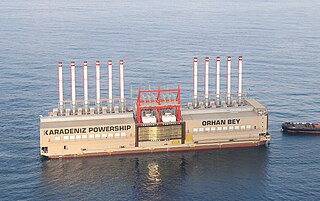
A powership is a special purpose ship, on which a power plant is installed to serve as a power generation resource.
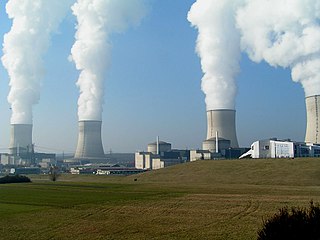
The electricity sector in France is dominated by its nuclear power, which accounted for 71.7% of total production in 2018, while renewables and fossil fuels accounted for 21.3% and 7.1%, respectively. France has the largest share of nuclear electricity in the world, and together with renewable energy supplies, this has helped its grid achieve very low carbon intensity.

The electricity sector in Switzerland relies mainly on hydroelectricity, since the Alps cover almost two-thirds of the country's land mass, providing many large mountain lakes and artificial reservoirs suited for hydro power. In addition, the water masses drained from the Swiss Alps are intensively used by run-of-the-river hydroelectricity (ROR). With 9,052 kWh per person in 2008, the country's electricity consumption is relatively high and was 22% above the European Union's average.

Energy in Jordan describes energy and electricity production, consumption and import in Jordan. Jordan is among the highest in the world in dependency on foreign energy sources, with 92.3% of the country's energy supply being imported.
Solar power in France including overseas territories reached an installed capacity figure of 11.2 GW in 2020, and rose further to 17.1 GW at the end of 2022. Government plans announced in 2022 foresee solar PV capacity in France rising to 100 GW by 2050.

Solar power in Morocco is enabled by the country having one of the highest rates of solar insolation among other countries— about 3,000 hours per year of sunshine but up to 3,600 hours in the desert. Morocco has launched one of the world’s largest solar energy projects costing an estimated $9 billion. The aim of the project was to create 2,000 megawatts of solar generation capacity by 2020. The Moroccan Agency for Solar Energy (MASEN), a public-private venture, was established to lead the project. The first plant, Ouarzazate Solar Power Station, was commissioned in 2016.
Under its commitment to the EU renewable energy directive of 2009, France has a target of producing 23% of its total energy needs from renewable energy by 2020. This figure breaks down to renewable energy providing 33% of energy used in the heating and cooling sector, 27% of the electricity sector and 10.5% in the transport sector. By the end of 2014, 14.3% of France's total energy requirements came from renewable energy, a rise from 9.6% in 2005.

The MV Karadeniz Powership Esra Sultan is a Powership, a floating power plant, owned and operated by Karpowership. Built in 2007, it was converted into a Powership in 2015 by Sedef Shipyard in Tuzla, Istanbul, Turkey. She was commissioned to supply electricity to the power grid in Ghana. Currently, she serves in Dakar, Sénégal.

The MV Karadeniz Powership Zeynep Sultan is a Liberia-flagged powership, a floating power plant, owned and operated by Karpowership. Built in 1984 by the Valmet Oy Helsingin Telakka in Vuosaari, Helsinki, Finland and christened MV Pavel Antokolsky, she sailed as a barge carrier under various names and flags until in 2015 she was converted into a Powership at the Sedef Shipyard in Tuzla, Istanbul, Turkey. She is commissioned to supply electricity to the power grid in Amurang, North Sulawesi, Indonesia.

The MV Karadeniz Powership İrem Sultan is a Liberia-flagged Powership, a floating power plant, owned and operated by Karpowership. Built in 1984 by the Fincantieri Marghera Shipyard in Venice, Italy and christened MV Nikolay Markin, she sailed as a barge carrier under various names and flags until in 2014 she was converted into a powership at the Sedef Shipyard in Tuzla, Istanbul, Turkey. She served in Nacala, Mozambique supplying electricity to Mozambique's power grid for land-locked Zambia. Currently, she serves in the Dominican Republic, and is stationed in Santo Domingo.

MV Karadeniz Powership Kaya Bey is a Liberia-flagged powership, a floating oil-burning power plant, owned and operated by Karpowership. Built in 1983 in Brazil and christened MV Gulf Grain, she sailed as a bulk carrier under various names and flags until she was acquired in 2009 to be converted into a Powership in Turkey. The Powership supplied electricity to the power grid in Pakistan, then in Basra, Iraq.
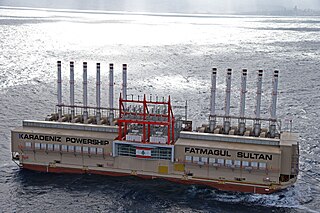
The MV Karadeniz Powership Fatmagül Sultan is a Liberia-flagged Powership, a floating power plant, owned and operated by Karpowership. Built as a barge, she was converted into a Powership in 2013 at Sedef Shipyard in Tuzla, Istanbul, Turkey. She is commissioned to supply electricity to the power grid in Lebanon.

The MV MV Karadeniz Powership Orhan Bey is a power barge, a floating power plant, owned and operated by Karpowership. She was commissioned in 2013, and initially contracted to supply electricity to the power grid in Lebanon.
Karpowership is a Turkish builder, operator, and owner of a fleet of powerships. Since 2010, 36 powerships have been completed with their total installed capacity exceeding 6,000 MW and further capacity under construction.

Électricité du Liban is a public industrial and commercial establishment in Lebanon which controls 90% of the country's electricity production, transmission and distribution activities.

